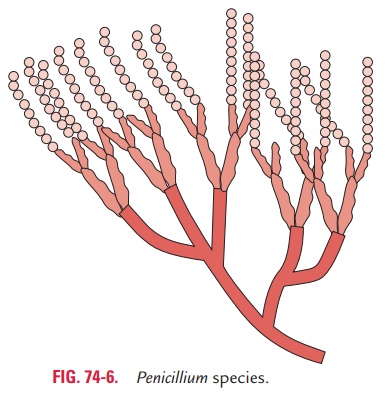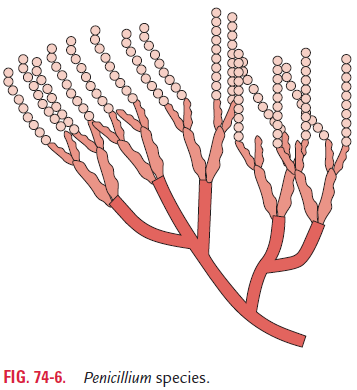Chapter: Microbiology and Immunology: Mycology, Fungi: Systemic Mycoses
Penicillium marneffei - Penicilliosis

Penicilliosis
Penicillium species rarely cause opportunistic infections in humans. The Penicillium species are identified by their typical morphology (Fig. 74-6), culture characteristics on the SDA medium (Color Photo 69), and microscopy (Color Photo 70). P. marneffei is the only dimorphic fungus in the genusPenicillium known to cause opportunistic infection.

Penicillium marneffei
P. marneffei is the only dimorphic fungus in the genus Penicillium. It has been reported as an important opportunistic pathogen in AIDS patients. The fungus causes tuberculosis-like disease in patients with AIDS in Southeast Asian countries like Thailand. Few case reports have also been documented from India.
Capponi and colleagues (1956) first demonstrated P. marneffei in liver of a bamboo rat. A laboratory-acquired case due to accidental inoculation of the skin was documented by Gabriel Segretian. Gabriel Segretian named the organism in honor of Hubert Marneffei. First case of natural human infection was reported by DiSalvo and colleagues (1973) in an American minister with Hodgkin’s disease.
Ability of the yeast forms to proliferate inside macrophages is the virulence characteristic of the fungus. The conidia attach to laminin, a glycoprotein in basement membrane, via sialic acid pathway and initiate the infection.
Incubation period is variable from few weeks to years. P. marneffei causes asymptomatic infections in immunocompetent hosts. It causes granulomatous or suppurative reaction, broncho-pneumonia with or without adenopathy, and cavitary lung lesion. It produces chronic cervical lymphadenitis resembling tuberculosis. Disseminated infections occur rarely in immuno-competent hosts.
P. marneffei causes disseminated infection in immuno-compromised hosts, such as patients with HIV. It develops a necrotizing reaction and involves the skin, lung, and intestine. It causes disseminated infections of reticuloendothelial system, and also allergic diseases and mycotoxicoses. The disseminated infection is more common in adults than in children.
P. marneffei is widely distributed in the nature. Its naturalhabitat is soil. The fungus infects no mammals other than humans and bamboo rat. Fungus is found in feces of rats and also in burrows made by the rats in the soil. The infection is transmitted by inhalation of conidia, direct inoculation of the skin, and rarely, by ingestion of infected rats. The condition is more common in rainy season, in rural areas.
Cell-mediated immunodeficiency, steroid treatment, and HIV infection are predisposing factors.
The fungus is endemic in Southeast Asian countries of Thailand, Vietnam, Laos, Myanmar, Singapore, and Indonesia. There has been recent increase in cases due to onset of AIDS pandemic. In India, 4 cases were reported by Singh and col-leagues (1999) from eastern state of Manipur.
Laboratory diagnosis of the infection is made by micros-copy, culture and serology:
Treatment of the condition is carried out by administration of amphotericin B for 2 weeks followed by oral itraconazole for 10 weeks.
Related Topics